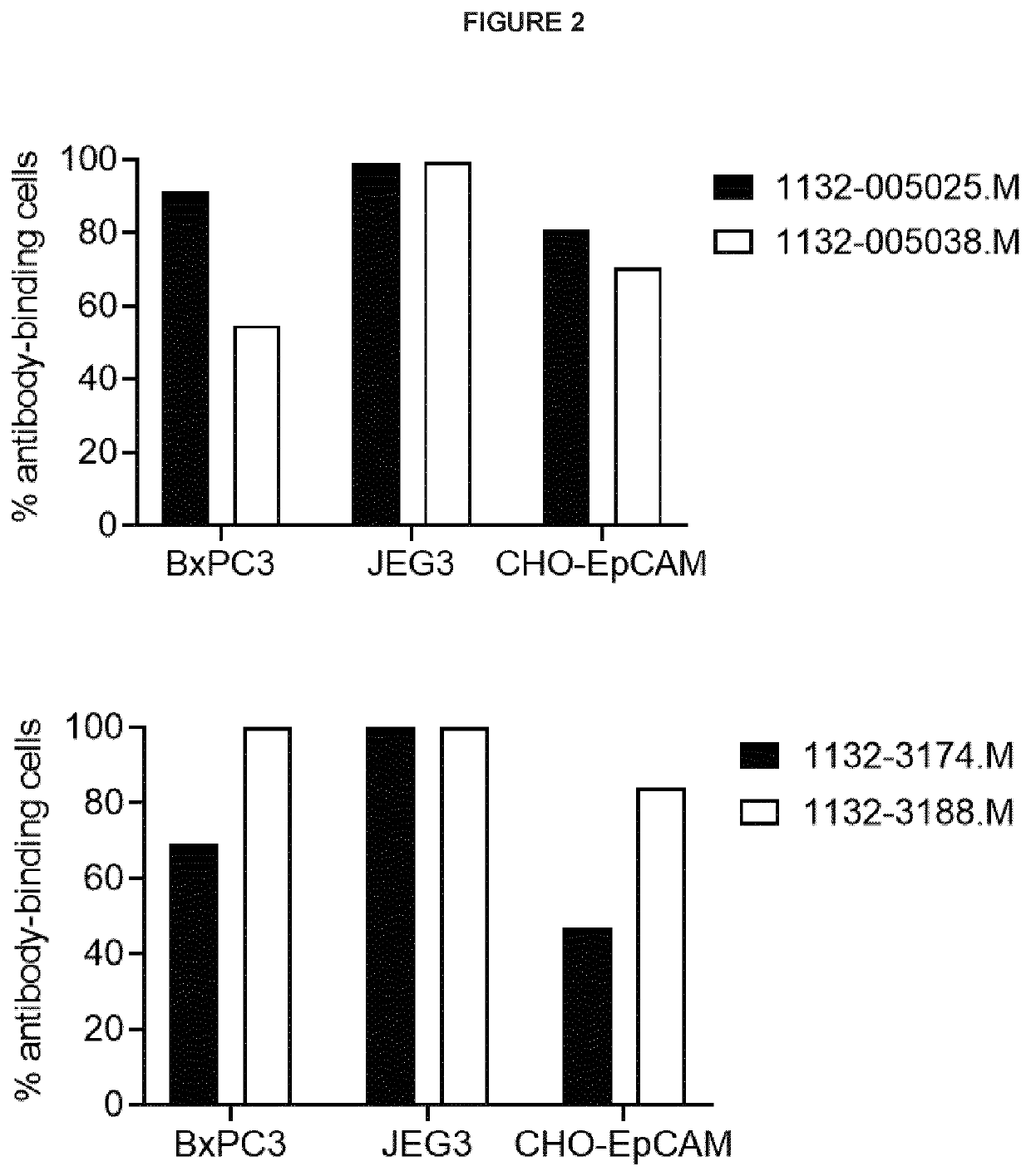Novel polypeptides
a polypeptide, bispecific technology, applied in the direction of immunoglobulins, antibody ingredients, instruments, etc., can solve the problems of inefficient anti-tumour response, low safety risk associated with this, and premature deaths in the developed world, so as to improve the immune activation and uptake. , the effect of superior anti-tumour immune respons
- Summary
- Abstract
- Description
- Claims
- Application Information
AI Technical Summary
Benefits of technology
Problems solved by technology
Method used
Image
Examples
example 1
ding of CD40-EpCAM bsAb Towards hEpCAM
Background and Aim
[0529]Binding was analysed with ELISA. The bispecific antibodies 1132-005025.M, 1132-005038.M, 1132-3188.M, 1132-3174.M (in Morrison format) and 1132-3174.R (in RUBY™ format) were analysed for binding towards human EpCAM.
Material and Methods
[0530]Plates were coated with 0.5 μg / mL hEpCAM (R&D Systems #9277-EP) in PBS over night at 4° C. After washing in PBS / 0.05% Tween 20 (PBST), the plates were blocked with PBS / 0.2% BSA for at least 30 minutes at room temperature before being washed again. Samples serially diluted from 50 nM in PBS / 0.02% BSA were then added and allowed to bind for at least 1 hour at room temperature. After washing, plates were incubated with 0.5 μg / mL biotinylated hCD40 (504-030 from Ancell) or HRP-labelled goat anti h-kappa light chain (Abd Serotec, #STAR127P), for at least 1 hour at room temperature. Dual antigen-complexed bsAb were detected with HRP-labelled streptavidin. SuperSignal Pico Luminescent was use...
example 2
Measurements of the EpCAM-Binding Domains
Background and Aim
[0532]Binding was measured by Octet. The bispecific antibodies 1132-005025.M, 1132-005038.M, 1132-3188.M, 1132-3174.M (in Morrison format) or 1132-3174.R (in RUBY™ format) were analysed for binding towards human EpCAM.
Material and Methods
[0533]Kinetic measurements were performed using the Octet RED96 platform (ForteBlo). The affinity evaluation was made with 3 different assays; Assay 1 with coupled bsAb and dimeric antigen EpCAM-Fc (Sino hEpCAM_Fc (0.25 mg / ml in PBS) #10694-H02H) in solution; Assay 2, with coupled bsAb and monomeric antigen EpCAM-his (R&D hEpCAM_His (500 ug / ml in PBS) #9277-EP) in solution; Assay 3 with coupled antigen (Sino hEpCAM_Fc (0.25 mg / ml in PBS) #10694-H02H) and bsAb in solution.
Assay 1 and 2
[0534]BsAb at 1.0 or 1.5 ug / ml where coupled to anti-human Fab-CH1 2nd generation (FAB2G) biosensors (Part no #18-5125 (tray)). Antigens were serially diluted % in 1× Kinetic buffer (ForteBio) to 100 nM, 50 nM, ...
example 3
f CD40-EpCAM Bispecific Antibodies to EpCAM-Expressing Cell Lines
Background and Aim
[0537]1132-3174.M, 1132-005025.M, 1132-005038.M and 1132-3188.M are CD40-EpCAM bispecific antibodies in the Morrison format wherein 1132 refers to the CD40 agonist domain and 3174, 005025, 005038 and 3188 to the EpCAM-binding, tumour-targeting, domain. The antibodies have been LALA-mutated to silence Fcγ receptor binding. The aim of this study was to assess the binding of the CD40-EpCAM bispecific antibodies to EpCAM expressed on cells.
Materials and Methods
[0538]The human EpCAM gene was cloned into pcDNA3.1, and the vector was subsequently stably transfected into CHO cells. The tumour cell line JEG, expressing high levels of EpCAM, BxPC3 expressing low levels of EpCAM and CHO-EpCAM cells were incubated with 1 μg / ml of 1132-3174.M, 1132-005025.M, 1132-005038.M or 1132-3188.M. Binding of the antibodies was detected using fluorochrome-conjugated anti-human IgG and analysed using flow cytometry.
Results an...
PUM
| Property | Measurement | Unit |
|---|---|---|
| Fraction | aaaaa | aaaaa |
| Fraction | aaaaa | aaaaa |
| Fraction | aaaaa | aaaaa |
Abstract
Description
Claims
Application Information
 Login to View More
Login to View More - R&D
- Intellectual Property
- Life Sciences
- Materials
- Tech Scout
- Unparalleled Data Quality
- Higher Quality Content
- 60% Fewer Hallucinations
Browse by: Latest US Patents, China's latest patents, Technical Efficacy Thesaurus, Application Domain, Technology Topic, Popular Technical Reports.
© 2025 PatSnap. All rights reserved.Legal|Privacy policy|Modern Slavery Act Transparency Statement|Sitemap|About US| Contact US: help@patsnap.com



